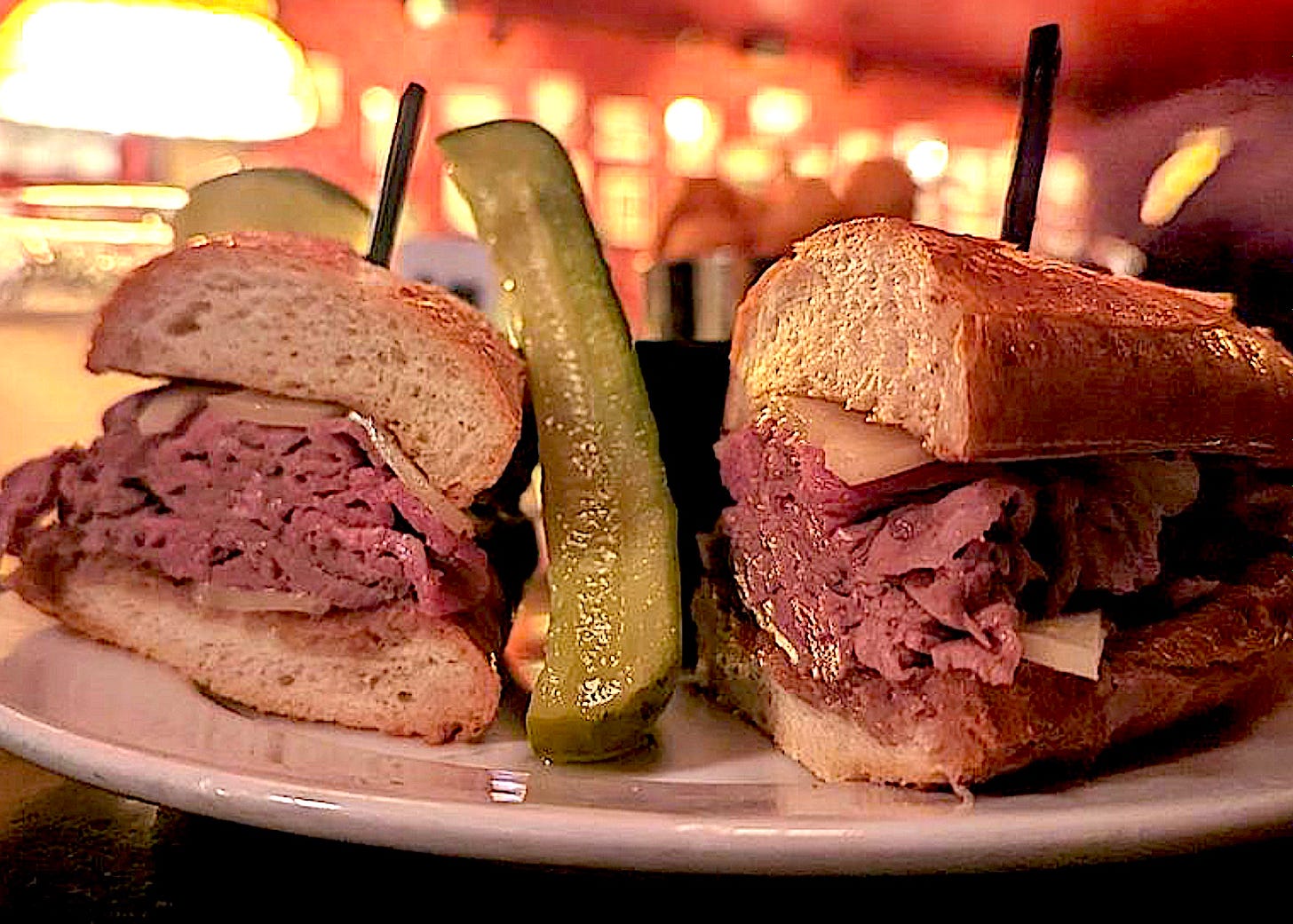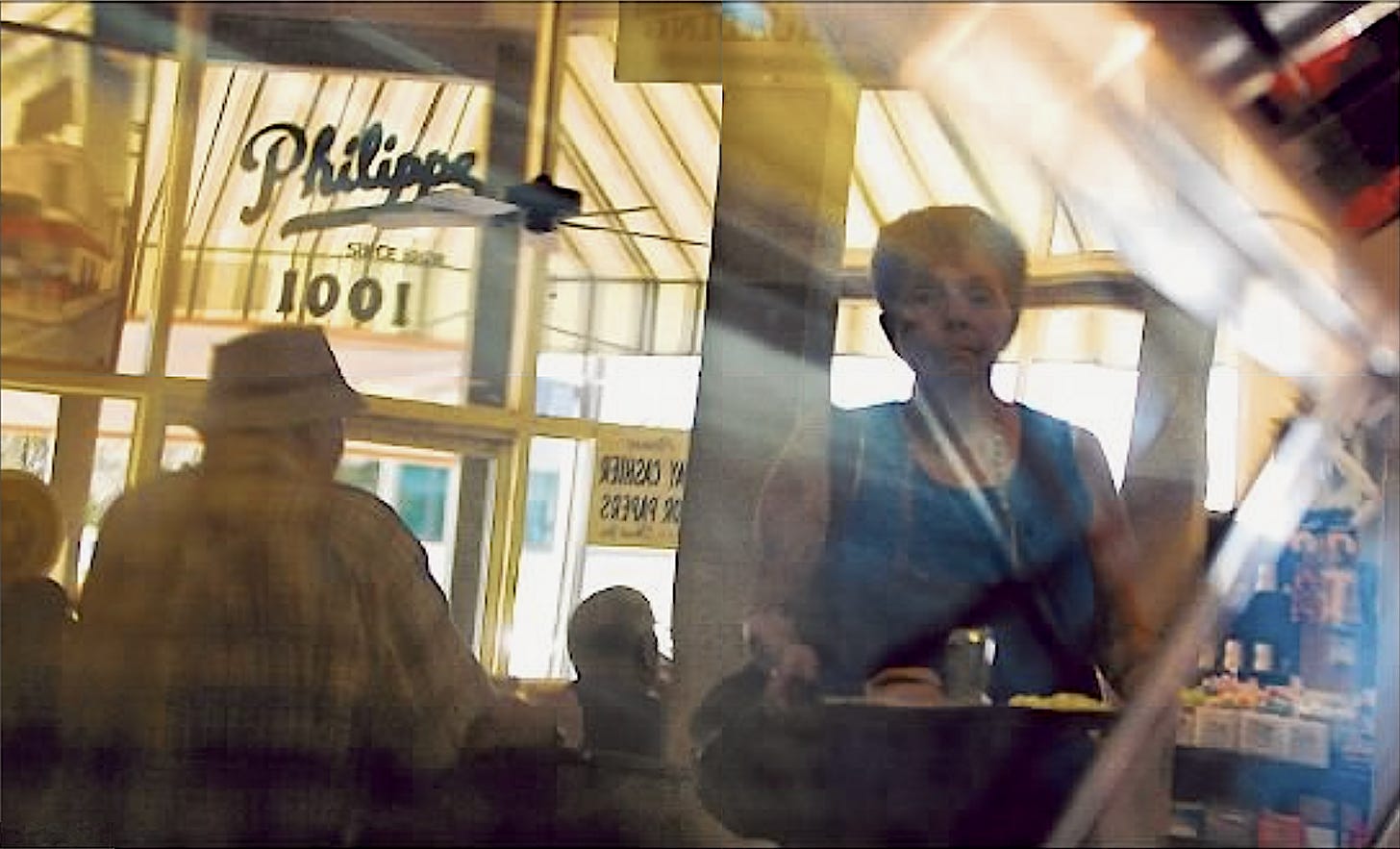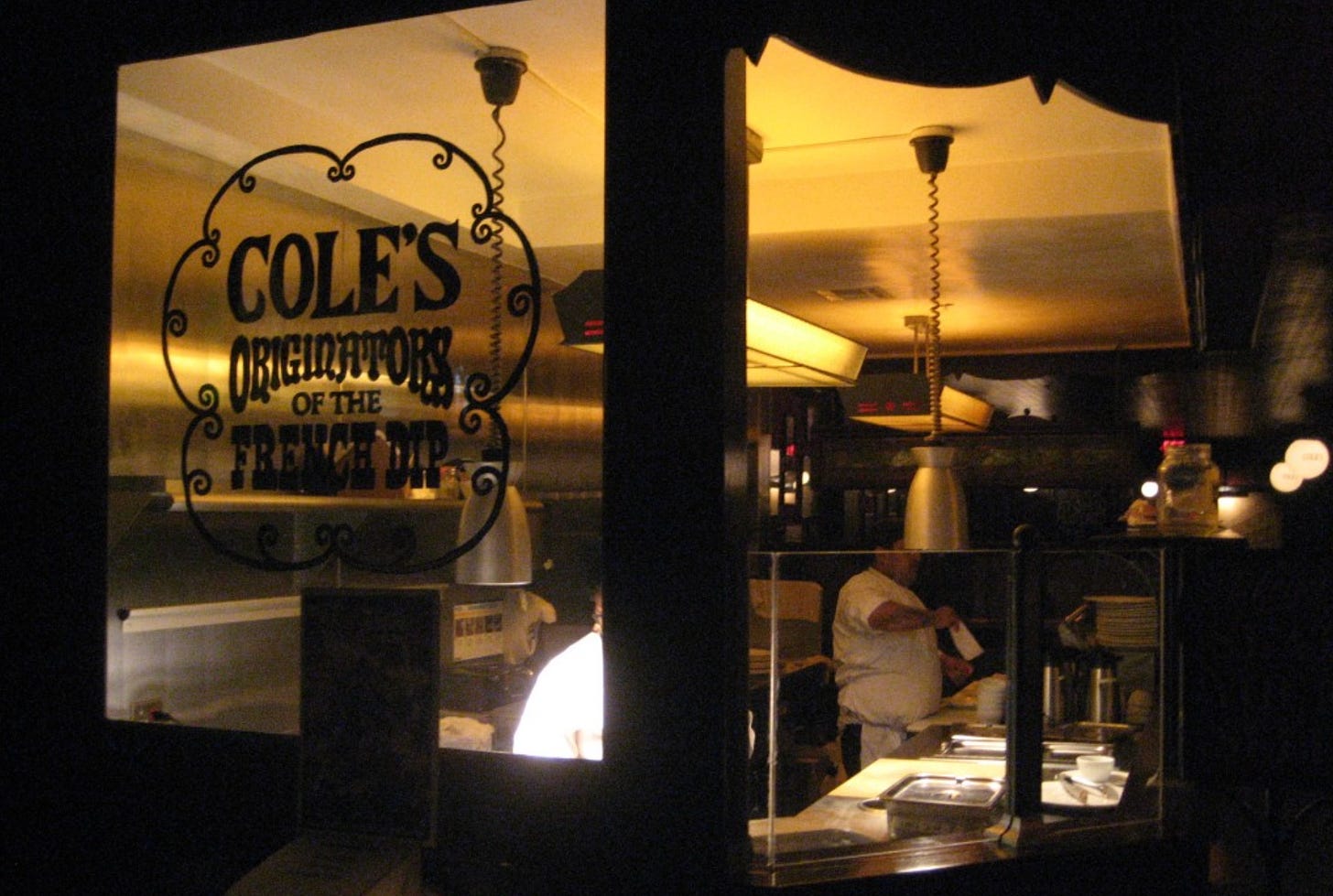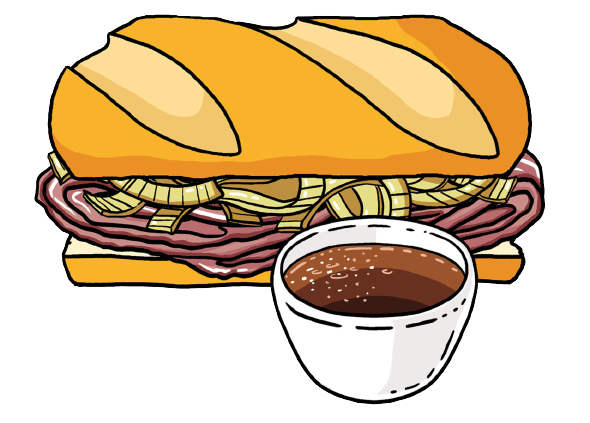Notable Sandwiches #69: French Dip
It's Philippe vs. Cole's in the battle of Los Angeles
Welcome back to Notable Sandwiches, a weekly feature in which Talia and I nibble our way through the bonkers document that is Wikipedia’s List of Notable Sandwiches, in alphabetical order. This week, a hotly-contested Los Angeles icon: the French dip.
We all love an origin story, and if there’s a little conflict involved, all the better. In cities across the country, restaurant rivalries — over who invented what dish and when — are a topic of heated discussion: Pat’s vs. Geno’s in the Philly cheesesteak wars; Matt's Bar and 5-8 Club in Minnesota, fighting over custody of the Juicy Lucy; Philippe and Cole’s in the battle of Los Angeles French dips. These last two establishments were founded in downtown L.A. in 1908, and are both still serving their customers today. Cole’s calls itself the “Originators French Dipped Sandwiches.” Philippe bills itself as the home of “The Original French Dipped Sandwich.” Can they both be right?
In order for a restaurant to stay in business for over a century, good food is important, but so is a good gimmick, and the invention of an iconic sandwich is a reliable one. The French dip is nothing if not iconic — Ruth Reichl called it “Los Angeles' best-known regional specialty” in 1984, and it’s frequently cited as the city’s most enduring contribution to the sandwich arts. “Today there are few old downtown restaurants that don't serve some version of French dip,” wrote Reichl in the Los Angeles Times. “If you want a real taste of the past, there is no better way to savor it than by going into our city's oldest eating establishments and ordering one of our oldest favorites.”
Cole’s is officially the oldest eatery in Los Angeles, having opened its doors in the hulking Pacific Electric Terminal in 1908; it claims to have first served the French dip that very same year. Philippe’s — opened by French immigrant Philippe Mathieu in its original location, also in 1908 — contends that they invented the sandwich a decade later. Most sources seem to lean towards Philippe’s claim, including the New York Times. But other more reputable sources disagree.
According to Cole’s lore, the restaurant’s head chef Jack Garlinghouse dipped a roast beef sandwich into a pan of drippings at the request of a patron suffering from sore gums; a soggy crust allowed him to eat his meal in relative comfort. A sensible solution to the patron’s woes. Philippe claims that, in 1918, a frazzled cook preparing a sandwich accidentally dropped the top half of the bread into a pan of drippings. The customer was in a hurry, took the gravy-soaked order anyway, ate it, loved it, and the rest was history.
The Sword and the Sandwich is a newsletter about deadly serious extremism and serious sandwiches. Please consider supporting this work with a paid subscription:
But that’s just one variation of the Philippe story. In some tellings, the customer was a policeman, in others a firefighter. The founder’s grandson, Philippe Guilhan, added a a further detail. “One day a fireman complained that his roll was stale,” he told the Los Angeles Times in 2008. “It was probably a Monday and the roll was a leftover from the weekend. My grandfather was a thrifty person. He said, ‘Give me the damn thing back. He dipped it in the juices and said, ‘You happy now?’”
That explanation came 90 years after the fact, and when Mathieu himself spoke to the Los Angeles Times in 1951, he told a different story: “One day a police officer asked me if I would mind splitting one of these large loaves of French bread and filling it with ‘some of the delicious roast pork.’ I was not too busy, so I said, ‘Sure.’ Then he asked me to ‘please cut it in half. I've got a friend outside who can eat it.’ Then he asked for some pickles, onions and olives.” According to Mathieu, the dipping came later: “We started making French-roll sandwiches for those who had smaller appetites. One day a customer saw some gravy in the bottom of a large pan of roast meat. He asked me if I would mind dipping one side of the French roll in that gravy. I did, and right away five or six others wanted the same.”
So, in the words of the namesake Philippe — the only truly French element in this whole saga — the original French dip was a roast pork sandwich with pickles, onions, and olives, with the “dip” only added at a later date. As Thrillist’s Jackson Landers wrote in a 2016 investigation, “No firefighter. No tantrum at a demanding customer. No my-chocolate-in-your-peanut-butter moment.”
For the record, I can buy the notion that Philippe Mathieu served some unsuspecting civil servant a new-fangled sandwich, which he then put on his menu as a French dip. “Mathieu's story seems more likely to be accurate because it avoids a satisfying 'eureka moment' cliché,” noted Landers. “It is also a first-person account, unlike every other version.” I’m just not sure I would call what Mathieu created a French dip.
My theory is that Philippe may have been the first to soak the sandwich bread in drippings, but the result was a far cry from the French dip of 2023. Still, if that seminal wet-meat concoction was as popular as they say, it makes sense that the nearby Cole’s would add a similar sandwich to its menu, and maybe even refine into something closer to what we know and love today. But if we’re arguing over who invented the French dip, doesn’t the answer come down to what a French dip is? According the definition in our beloved Wikipedia list, the sandwich consists of “thinly sliced roast beef on a baguette, served hot, usually au jus.” That’s the version I knew growing up, but it’s not what Philippe Mathieu served back in 1918.
When it comes to restaurant wars, it’s not just about who did it first, of course, but who does it best. A 2016 head-to-head matchup in Los Angeles Magazine gave the belt to Philippe. “If you were to guess who invented the French dip based on taste alone, you’d go with Philippe's. No question,” wrote Josh Scherer. “Cole’s legitimately tastes like a cheap imitator — someone who tried to copy the French dip formula but left out all the little things that matter.”
That may have been a reasonable conclusion in 2016, but it wasn’t always the case. In that 1984 Times article, Ruth Reichl concluded, “while Philippe's has tradition on its side, if you ask me, the French dip tastes better at Cole's.” When it comes to Los Angeles cuisine, though, we should give the final word to the late, great Jonathan Gold, who wrote about the French dip frequently in his decades-long Pulitzer Prize-winning career.
“When you trip down out of the bright sunlight into the dim warren of Cole's, you stumble into another era, with real Tiffany lamps, sawdust on the floors, and a couple of pickle-nosed guys at the bar who look like they haven't budged from their stools since 1946,” Gold wrote in the L.A. Times in 1990. “Cole's, where French-dipping was reputedly invented, serves huge, glorious sandwiches, and you'll lunch as well here as at any counter in town. The sandwiches are even better than Phillippe's.”
There you have it. In this restaurant battle, Philippe may well have been first, but it’s Cole’s that takes the Gold.










The two restaurants serve different styles of the dip, making personal preferences very subjective. Coles serves the sandwich undipped with a side of jous, on something like an actual baguette. Philippe’s is dipped when served (level of wetness to order), on an elongated roll.